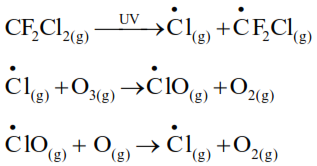Given below are two statements :
Statement I : Chlorofluoro carbons breakdown by radiation in the visible energy region and release chlorine gas in the atmosphere which then reacts with stratospheric ozone.
Statement II : Atmospheric ozone reacts with nitric oxide to give nitrogen and oxygen gases, which add to the atmosphere.
For the above statements choose the correct answer from the options given below :
Correct Option: , 2
Statement (1)
CFCs are broken down by powerful UV radiation and releases chlorine free radical which reacts with ozone and start chain reaction.

Statement (2)
Atmosphere ozone reacts with nitric oxide to produce nitrogen dioxide and oxygen.
$\mathrm{NO}_{(\mathrm{g})}+\mathrm{O}_{3(\mathrm{~g})} \rightarrow \mathrm{NO}_{2(\mathrm{~g})}+\mathrm{O}_{2(\mathrm{~g})}$
Click here to get exam-ready with eSaral
For making your preparation journey smoother of JEE, NEET and Class 8 to 10, grab our app now.
